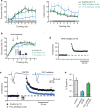Dopamine Promotes Motor Cortex Plasticity and Motor Skill Learning via PLC Activation
- PMID: 25938462
- PMCID: PMC4418826
- DOI: 10.1371/journal.pone.0124986
Dopamine Promotes Motor Cortex Plasticity and Motor Skill Learning via PLC Activation
Abstract
Dopaminergic neurons in the ventral tegmental area, the major midbrain nucleus projecting to the motor cortex, play a key role in motor skill learning and motor cortex synaptic plasticity. Dopamine D1 and D2 receptor antagonists exert parallel effects in the motor system: they impair motor skill learning and reduce long-term potentiation. Traditionally, D1 and D2 receptor modulate adenylyl cyclase activity and cyclic adenosine monophosphate accumulation in opposite directions via different G-proteins and bidirectionally modulate protein kinase A (PKA), leading to distinct physiological and behavioral effects. Here we show that D1 and D2 receptor activity influences motor skill acquisition and long term synaptic potentiation via phospholipase C (PLC) activation in rat primary motor cortex. Learning a new forelimb reaching task is severely impaired in the presence of PLC, but not PKA-inhibitor. Similarly, long term potentiation in motor cortex, a mechanism involved in motor skill learning, is reduced when PLC is inhibited but remains unaffected by the PKA inhibitor. Skill learning deficits and reduced synaptic plasticity caused by dopamine antagonists are prevented by co-administration of a PLC agonist. These results provide evidence for a role of intracellular PLC signaling in motor skill learning and associated cortical synaptic plasticity, challenging the traditional view of bidirectional modulation of PKA by D1 and D2 receptors. These findings reveal a novel and important action of dopamine in motor cortex that might be a future target for selective therapeutic interventions to support learning and recovery of movement resulting from injury and disease.
Conflict of interest statement
Figures





Similar articles
-
Dopamine in motor cortex is necessary for skill learning and synaptic plasticity.PLoS One. 2009 Sep 17;4(9):e7082. doi: 10.1371/journal.pone.0007082. PLoS One. 2009. PMID: 19759902 Free PMC article.
-
Motor learning and metaplasticity in striatal neurons: relevance for Parkinson's disease.Brain. 2018 Feb 1;141(2):505-520. doi: 10.1093/brain/awx351. Brain. 2018. PMID: 29281030
-
Dopaminergic projections from midbrain to primary motor cortex mediate motor skill learning.J Neurosci. 2011 Feb 16;31(7):2481-7. doi: 10.1523/JNEUROSCI.5411-10.2011. J Neurosci. 2011. PMID: 21325515 Free PMC article.
-
Dopamine D1-like receptors and reward-related incentive learning.Neurosci Biobehav Rev. 1998 Mar;22(2):335-45. doi: 10.1016/s0149-7634(97)00019-5. Neurosci Biobehav Rev. 1998. PMID: 9579323 Review.
-
Circuit changes in motor cortex during motor skill learning.Neuroscience. 2018 Jan 1;368:283-297. doi: 10.1016/j.neuroscience.2017.09.010. Epub 2017 Sep 14. Neuroscience. 2018. PMID: 28918262 Free PMC article. Review.
Cited by
-
Antizyme Inhibitor 2-Deficient Mice Exhibit Altered Brain Polyamine Levels and Reduced Locomotor Activity.Biomolecules. 2022 Dec 21;13(1):14. doi: 10.3390/biom13010014. Biomolecules. 2022. PMID: 36671399 Free PMC article.
-
General Principles of Neuronal Co-transmission: Insights From Multiple Model Systems.Front Neural Circuits. 2019 Jan 21;12:117. doi: 10.3389/fncir.2018.00117. eCollection 2018. Front Neural Circuits. 2019. PMID: 30728768 Free PMC article. Review.
-
Does Dysregulation Of The Indirect Pathway Contribute To The Pathophysiology Of Catatonia Through Neurotransmitter Imbalance?Clin Neuropsychiatry. 2025 Jun;22(3):229-242. doi: 10.36131/cnfioritieditore20250306. Clin Neuropsychiatry. 2025. PMID: 40735384 Free PMC article.
-
Catatonia.Nat Rev Dis Primers. 2024 Jul 18;10(1):49. doi: 10.1038/s41572-024-00534-w. Nat Rev Dis Primers. 2024. PMID: 39025858 Review.
-
Pharmacological Dopamine Manipulation Does Not Alter Reward-Based Improvements in Memory Retention during a Visuomotor Adaptation Task.eNeuro. 2018 Jul 16;5(3):ENEURO.0453-17.2018. doi: 10.1523/ENEURO.0453-17.2018. eCollection 2018 May-Jun. eNeuro. 2018. PMID: 30027109 Free PMC article.
References
-
- Gorelova N, Seamans JK, Yang CR. Mechanisms of dopamine activation of fast-spiking interneurons that exert inhibition in rat prefrontal cortex. Journal of Neurophysiology 2002;88:3150–3166. - PubMed
Publication types
MeSH terms
Substances
LinkOut - more resources
Full Text Sources
Other Literature Sources

